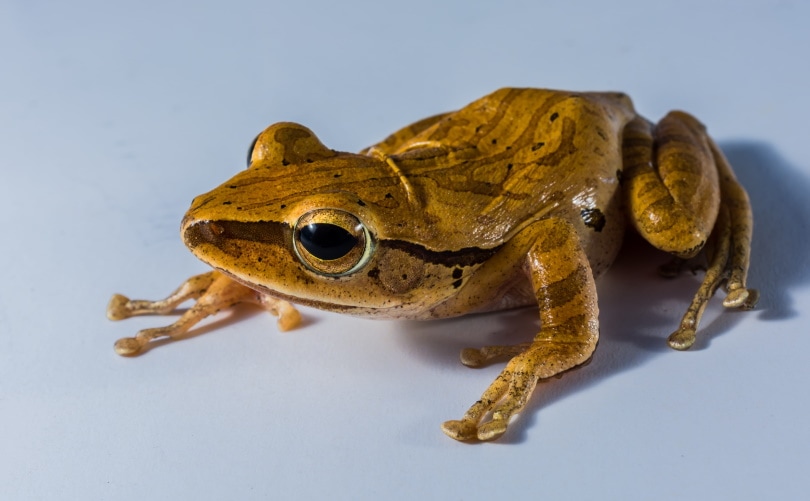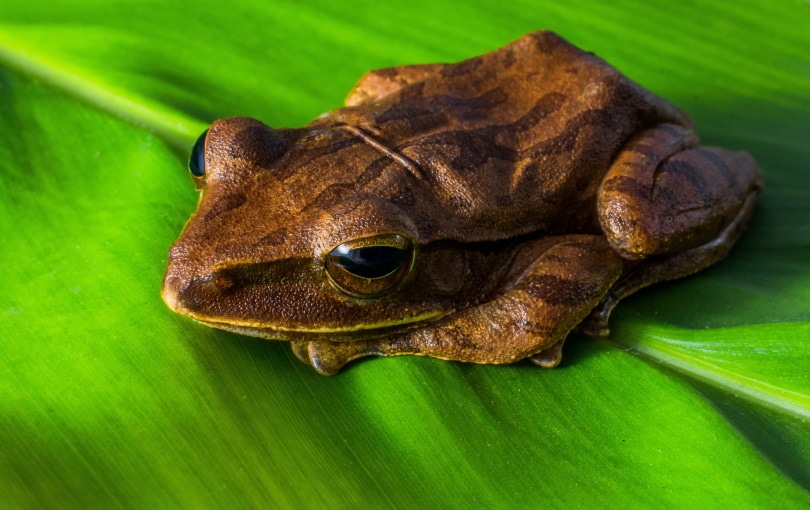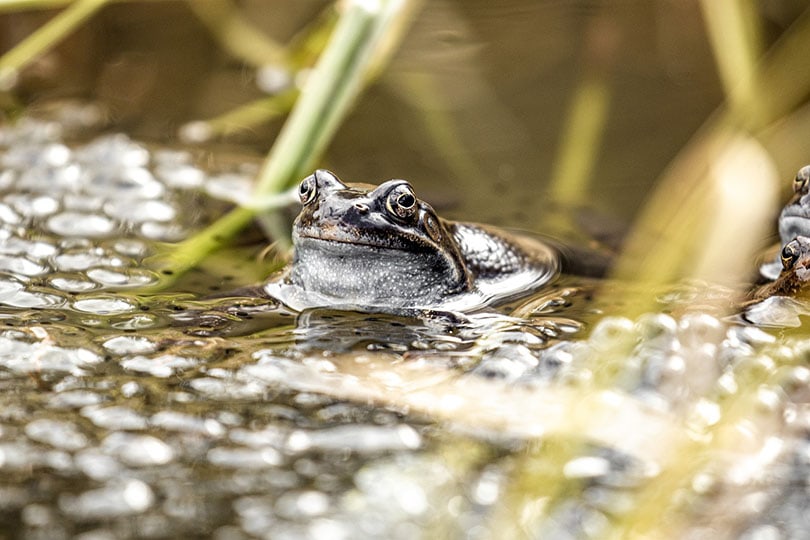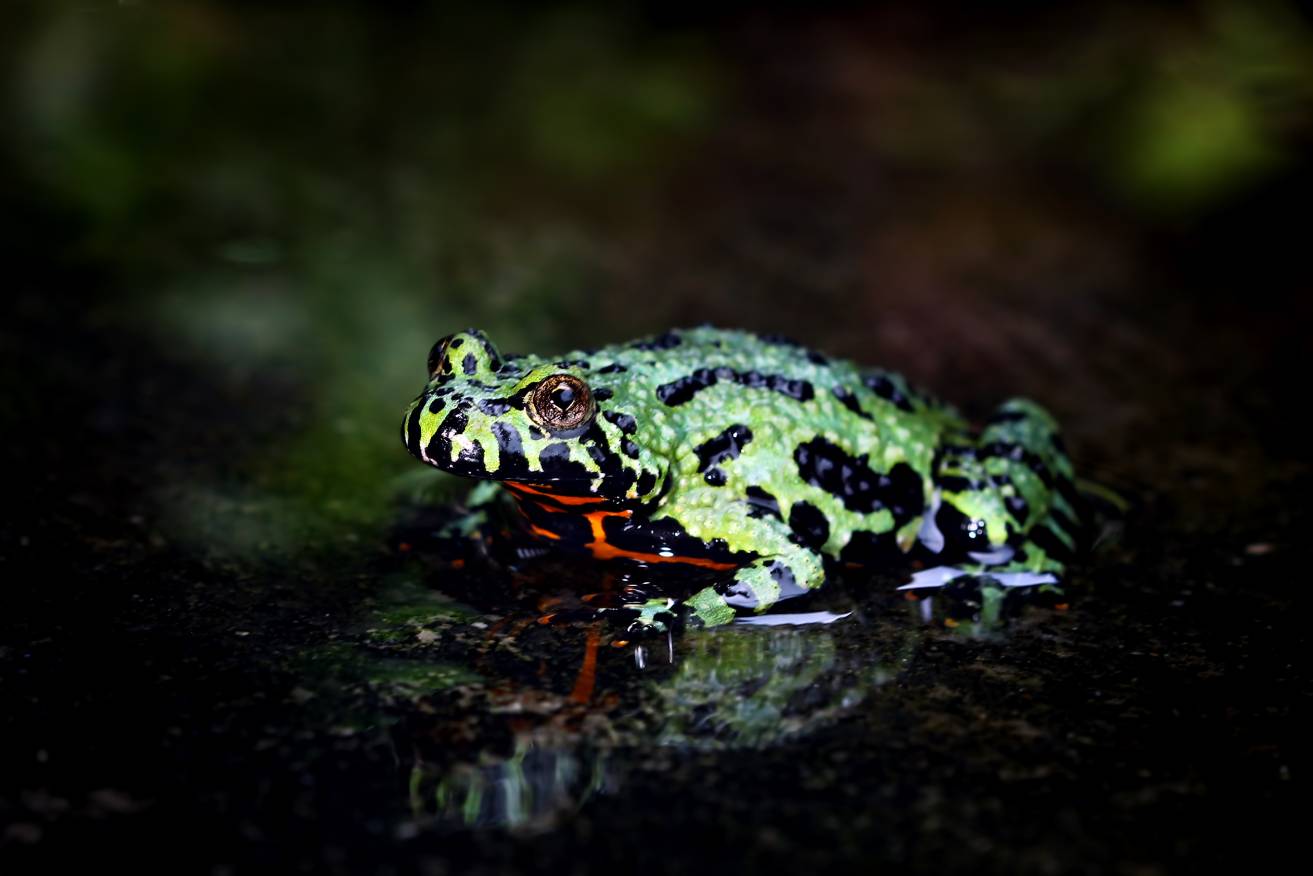
The Golden Tree Frog is known by a variety of different names: Common Tree Frog, Four-Lined Tree Frog, and Striped Tree Frog. They are sometimes confused with the Common Indian Tree Frog. However, they are different species.
The Golden Tree Frog is native to subtropical and tropical dry forests. They are also common in urban areas, plantations, irrigated land, and other human environments.
In damp areas, these frogs are present year-round. In warmer, dry areas, they commonly leave for damper areas during the hottest months. Mating takes place in shallow pools, where the males call the females with their distinctive call. Then, the females lay 100 to 400 eggs in a protected nest attached to vegetation in the pool. After a few days, the eggs hatch.
Quick Facts About the Golden Tree Frog
| Species Name | Phytotriades auratus |
| Family | Rhacophoridae |
| Care Level | Low |
| Temperature | 74 to 76 degrees Fahrenheit |
| Temperament | Docile |
| Color Form | Varied |
| Lifespan | 5 years |
| Size | 1.5 to 3 inches |
| Diet | Insects |
| Minimum Tank Size | 18 x 18 x 24 |
| Tank Setup | Multiple climbing structures, large “pond” |
| Compatibility | Same species |
Golden Tree Frog Overview

The Golden Tree Frog is quite similar to other tree frogs. They require a habitat that is relatively warm and humid. Beyond their specific humidity needs, they do not require complicated care. If you’re able to keep their humidity at a high enough level, then this species can be great for beginners.
Like most frogs, they live on insects. Typically, you can release a few crickets into their tank, and they will feed on them. Juveniles need to be fed more than adults, but they still don’t require tons of food. They are docile animals, so they can be kept in groups.
Breeding them in captivity is a little complicated, as you need to use a rain chamber. However, professional breeders are often quite good at getting this correct, so captive-bred frogs are often available. We recommend captive-bred over wild-caught frogs, as they are usually healthier.
How Much Do Golden Tree Frogs Cost?
Golden Tree Frogs are some of the least expensive tree frogs that you can purchase. Generally, they only cost about $30 from most retailers. We recommend purchasing from a breeder, as wild-caught frogs are often less healthy and adaptable. This is due to the challenging shipping process that they must undergo and the significant difference between captivity and the wild. If you want frogs that are adaptable and healthy, purchase from a breeder.
Ask the breeder to see where the parents and the younger frogs are kept, as this will give you an idea of how well the frogs are cared for.
That said, successful breeding in captivity occurs only occasionally, so it may be difficult to find breeders with available frogs. Overall, these frogs seem to be sporadically available. There may be many available in your area at once and then absolutely none a week later.
Typical Behavior & Temperament

These frogs are easily kept in groups, especially when they are younger. But it is essential to ensure that all the frogs are getting the necessary food, as some may hoard it from others. Males will often attempt to mate constantly, which can stress the females out. For this reason, many people house their females and males separately.
Another way to prevent constant mating is to lower the humidity. This will decrease the overall health of the frogs, though.
Appearance & Varieties
Golden Tree Frogs are often described as medium to large frogs. They have a distinctive point on their nose. Often, individuals are somewhere between tan and a golden yellow. The colors and patterns vary widely between frogs. They can be a solid color or patterned with dark spots or X-shaped markings.
Overall, these frogs can range from an excellent tan to a lightly striped gray. Some will have dark outlines around their face, and others are highly patterned. Secondary colors of tan, beige, brown, and gray are all quite common. Usually, these frogs have a ventral stripe that is somewhere around white or cream.
Some experts speculate that this species is highly complex in the wild, with different areas producing frogs of different colors. In some cases, the very different-looking frogs may be a separate species that simply hasn’t been identified as such.
These frogs usually measure about 2 ½” to 3″. Females are usually at the higher part of this range, while males are considerably smaller. When you purchase a frog, they will likely be very small, around 1 ¼”. They will reach their full size in a few months. They cannot be housed in an appropriate juvenile tank long for this reason. It is often best to treat the juveniles as adults when it comes to their tank and housing needs.
As adults, these frogs have distinct differences between the sexes. The females are quite a bit larger than the males by ½” to 1″. They also have a wider head, even when you take their larger size into account. They are about 50% heavier as well, so the difference is easily discernable. However, froglets are more difficult to sex, as their size depends more on their age.
How to Take Care of Golden Tree Frogs
Habitat, Tank Conditions & Setup
Generally, these frogs are easy to house. They need a large enclosure that measures at least 18 x 18 x 24 for a small group of two to four frogs. If you want to keep more frogs, you will need a larger tank.
Exactly what substrate you should use will vary by whom you ask about it! Generally, sphagnum moss, damp paper towels, or finely ground coconut fibers are your best bet. The important part is that the substrate can hold enough moisture to stay at a healthy level. Otherwise, the tank will dry out too quickly. You should also be able to spot-clean the tank without too much of a problem.
It is also essential that the substrate is small enough to pass through the frog’s tiny digestive systems. Frogs may accidentally eat pieces of wood and similar substrates, which can cause impaction and death. Be sure to pack down whatever you’re using so the frog doesn’t mistake it as a bug.
There are various frog-safe substrates out there. For instance, there are even types of foam that are explicitly made for frogs. These can work as well, especially since they hold in the moisture just fine and can’t be eaten. Most substrates will need to be cleaned two to three times a week, though spot-cleaning more often is recommended.
These frogs also need a constant source of fresh water. We recommend a massive bowl of water. Change it daily, and clean it to prevent bacteria build-up. The frogs will use the dish to do their business, so cleaning it daily is essential. You should use water that has been treated to remove chemicals. Frogs absorb just about everything that comes in contact with their skin, so they mustn’t be exposed to chemicals.

Golden Tree Frogs thrive most when their tank temperature is kept stable — 74 to 76 degrees Fahrenheit is the best option for most frogs. Unlike some species of frogs, Golden Tree Frogs do not need their tank temperature to be super high. In fact, if the tank reaches the high 80s, they can quickly dehydrate and die. This is especially true if it is coupled with low humidity or a lack of water. This is one reason that shipping these frogs can be somewhat tricky. The low humidity, lack of water, and heat often dehydrate the frogs and lead to their death.
They do require decently high humidity. It is best kept around 60% to 70%. You should measure it constantly to ensure that the proper humidity is being kept. Otherwise, the frogs can dehydrate and die. Mist the cage daily to increase the humidity. If your tank needs to be more humid, we recommend increasing the amount of misting that you do. A larger dish will also help provide some of the necessary humidity.
Ventilation is essential, so at least half of the tank’s top should allow for airflow. Stagnant conditions encourage the growth of bacteria, which can be dangerous for frogs.
Because they are tree frogs, perches of all sorts are recommended. You can use cork board, driftwood, PVC pipes, and even vines. Live plants can be used, especially if they have broad leaves, to provide an appropriate amount of cover. Fake plants can be wrapped around perches to make the habitat look more natural and provide hiding places for the frogs.
What to Feed Your Golden Tree Frogs
Like most frogs, Golden Tree Frogs feed on insects in the wild and in captivity. Their diet will include mostly crickets, as these are the most straightforward insect to find in varying sizes in most places. Most pet stores sell crickets of all different sizes. You should choose ones that are smaller than the space between your frog’s eyes. This is the size of their mouth, and they can’t eat anything larger than their mouth. You do not want them to choke while attempting to eat.
Of course, you will need to increase the size of the prey as they get older. While you can feed small crickets to larger frogs, they will need a large amount of them. Some may even become uninterested in smaller insects as they get bigger.
Feed each frog two to three times a week. Use about two to eight crickets each time, depending on their sizes. If the crickets are near the frog’s maximum range, you’ll likely only need two or three. If they are smaller, then you may need as many as eight. Juveniles should be fed daily, as they are growing and need the extra calories.
A few times a month, you can offer other foods, such as wax worms, mealworms, moths, flies, and other insects. These should be substituted for the crickets, not fed on top of the crickets.
Because they are nocturnal, these frogs should only be fed at night. They will often wake up if food is introduced during the day, but it is best to stick to their natural sleep cycle. Furthermore, not all frogs will wake up during feeding time during the day, and they’ll miss out on food.
These frogs do require a vitamin and mineral supplement. Choose a high-quality supplement, and use it every other feeding for adults. Use it during every feeding for juveniles, as they need the extra vitamins to grow appropriately.
Keeping Your Golden Tree Frog Healthy
These frogs are generally healthy. As long as they are in the appropriate environment, they usually don’t require much special care. However, if the metrics of their tank are off, they can develop problems. For example, low ventilation can cause bacterial and fungal growth in the frogs’ tank’s high-humidity environment. Sometimes, frogs can even develop fungal infections on their skin. These will need to be treated and the ventilation improved.
Frogs that are not provided with the correct supplements will become deficient in specific vitamins. For instance, calcium and vitamin D are required for bone health. If a frog is deficient in either of these vitamins, they may quickly develop brittle bones. They can break their bones in the process of moving around, or deformities can occur if the frog is still a juvenile.
You must stick to these requirements, or your frog may become quite sickly and develop problems. Otherwise, these frogs can live for years in captivity.
Breeding

One of the few times that Golden Tree Frogs travel to the ground is to breed. In the wild, they breed in small pools of water on the forest floor. Eggs are laid on the underside of vegetation overhanging the pond in a foam nest. When the eggs hatch, the tadpoles fall and land into the pool. The tadpoles grow quickly over 8-10 weeks. Because these frogs are larger than average, the tadpoles still have quite a bit of growing to do before they are fully grown. Young frogs may hang around the pool for a time before they venture back into the trees.
In captivity, these frogs are usually bred in rain chambers. This requires a specialized setup, so these frogs are somewhat difficult to breed in captivity. Rain chambers are enclosures that simulate the rainy season, which is when frogs would naturally breed. By putting them in the rain chamber, the frogs believe that it is breeding season and begin mating.
Are Golden Tree Frogs Suitable for You?
Golden Tree Frogs are generally easy to take care of. They don’t require complicated care and can be cared for similarly to most other tree frogs. They live on a diet of crickets and other insects, which is easy to achieve. They can be kept in groups with ease, especially if all the frogs are females. (However, this is hard to do, as most frogs are purchased before being sexed.)
The hardest thing for beginners to accomplish is the high humidity that these frogs require. Regular misting and proper substrate are a few ways that you can keep the humidity as high as these frogs need. Depending on your local climate, though, you may need to mist multiple times a day.
If you’re looking for a pet frog, this is a great species to start with.
- You may also like: Waxy Monkey Tree Frog: Care Sheet, Lifespan, Pictures & More
Featured Image Credit: MamaWirbel _Pixabay







